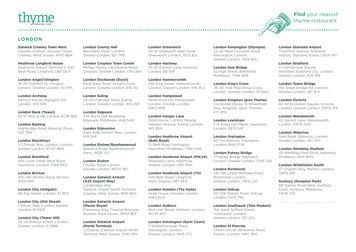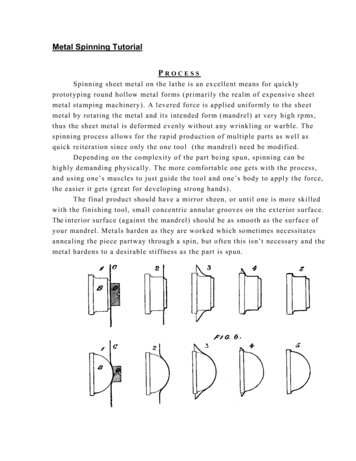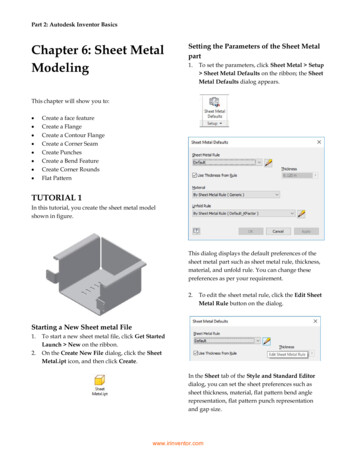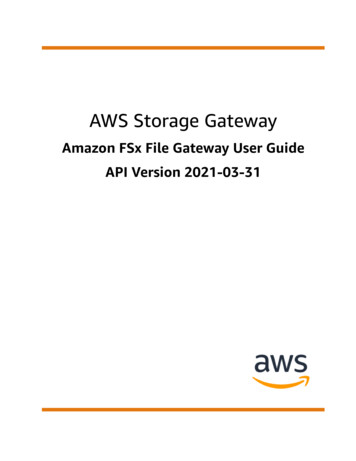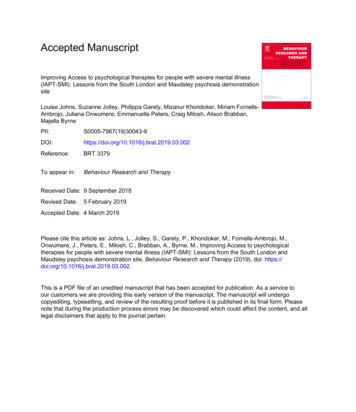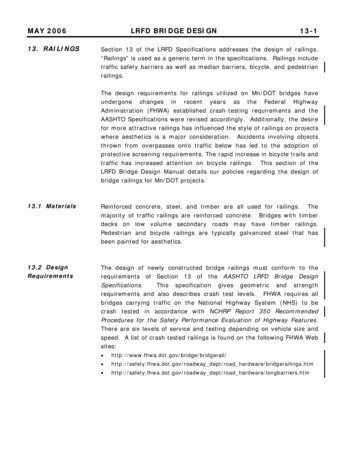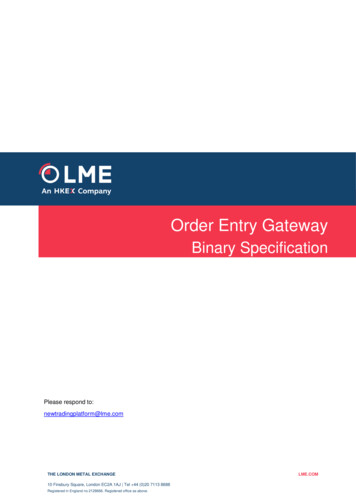
Transcription
Order Entry GatewayBinary SpecificationPlease respond to:newtradingplatform@lme.comTHE LONDON METAL EXCHANGE10 Finsbury Square, London EC2A 1AJ Tel 44 (0)20 7113 8888Registered in England no 2128666. Registered office as above.LME.COM
Order Entry GatewayBinary SpecificationVersion 1.1LME Classification: PublicTable of Contents1 Session Management . 91.1Authentication . 91.1.1Comp ID . 91.1.2Password Encryption . 91.1.3Password . 91.1.4Change Password . 91.2Establishing a Binary Session . 101.3Message Sequence Numbers . 101.4Heartbeat and Test Request . 111.5Terminating a Binary Session . 111.6Re-establishing a Binary Session . 111.7Sequence Reset . 121.8Fault Tolerance . 121.9Checksum Validation . 122 Recovery . 132.1General Message Recovery . 132.2Resend Request . 132.3Logon Message Processing – Next Expected Message Sequence . 142.4Possible Duplicates . 142.5Possible Resends . 142.6Gap Fills . 142.7Transmission of Missed Messages . 153 Service Description . 163.1Security Identification. 163.2Security Creation . 163.2.1Strategies . 163.3Order Submission . 183.4Order Types . 183.5Order Validity Conditions . 203.6Order Types and Permitted Order Validity Conditions . 213.7Order Identification . 213.8Order Expiry. 21Page 2
Order Entry GatewayBinary SpecificationVersion 1.1LME Classification: Public3.9Order Restatement . 223.10Order Amendment . 223.11Order Cancellation . 233.12Mass Cancellation . 233.13Cancel on Disconnect . 243.14Mass Quote . 253.15Request for Quote (RFQ) . 263.16Speed Bumps . 273.17Message Throttling . 363.18Security Definition Throttle . 373.19Merged Order Books . 373.20Self Execution Prevention (SEP) . 393.21Market Maker Protection (MMP) . 403.22Inflight Order Processing . 413.23Trade Reporting . 423.24Client ID Usage . 434 Message Definitions . 444.1Inbound Messages . 444.2Outbound Messages. 444.3Data Types . 454.4Message Composition . 474.4.1Fields Presence Map . 474.4.2Repeating Blocks and Nested Repeating Blocks . 484.5Required Fields . 494.6Message Header . 494.7Message Trailer . 504.8Administrative Messages . 514.8.1Logon (5) . 514.8.2Heartbeat (0) . 524.8.3Test Request (1) . 524.8.4Resend Request (2) . 524.8.5Sequence Reset (4) . 564.8.6Logout (6) . 56Page 3
Order Entry GatewayBinary Specification4.8.74.9Version 1.1LME Classification: PublicReject (3) . 57Other Messages . 574.9.1Business Message Reject (7) . 574.9.2News (40) . 584.10Application Messages . 604.10.1Security Definition Request (10) . 604.10.2Security Definition (11) . 624.10.3New Order Single (12) . 654.10.4Amend Order (13) . 714.10.5Order Amend Rejected (14) . 794.10.6Cancel Order (15) . 804.10.7Order Cancel Rejected (16) . 814.10.8Execution Report (8) . 824.10.9Mass Cancel Request (17) . 1054.10.10Mass Cancel Report (18) . 1074.10.11Mass Quote (22) . 1104.10.12Mass Quote Ack (23) . 1134.10.13Quote Request (20) . 1214.10.14Quote Request Ack (21) . 1214.10.15MMP Reset Request (30) . 1234.10.16MMP Reset Ack (31) . 123Page 4
Order Entry GatewayVersion 1.1LME Classification: PublicBinary SpecificationDocument HistoryVersionDateChange Description1.027/07/2020Initial draft1.128/01/2022Internal reviewPage 5
Order Entry GatewayVersion 1.1LME Classification: PublicBinary SpecificationPrefaceThis document describes the binary interface protocol of the LME Order Entry Gateway.The terminology used, message format, message flow and event models described throughout thisdocument are similar to that of FIX 5.0 SP2 protocol specifications (https://www.fixtrading.org) whereapplicable, with some specific changes for performance and adaptability reasons.Note message flow examples in this document are illustrations and do not contain all the mandatoryfields. The presence of ( ) denotes that fields have been omitted.Bit position is shown as BP in the message definitions.Delivery PhasingThis document covers all the functionality available in LMEselect 10 however functionality will bedelivered in phased releases.Functionality that will be included in a later release is specified in the following table and shownthroughout the document in dark grey italics. The initial release will contain all functionality that is notspecified in the table.FunctionReferenceFutures strategies:3.2.1.1 Exchange Defined Strategy Types 3 Month Average6 Month Average12 Month AverageCarry AverageOptions strategies: Call spreadPut spreadCustom strategies4.10.1 Security Definition Request (10)3.2.1.1 Exchange Defined Strategy Types4.10.1 Security Definition Request (10)3.2.1. Strategies3.2.1.2 Custom Strategies4.10.1 Security Definition Request (10)4.10.2 Security Definition (11) (Example Message Flows)4.10.8 Execution Report (8) (Example Message Flow)Option contracts3.2 Security Creation3.2.1.1 Exchange Defined Strategy Types3.2.1.2 Custom Strategies4.10.1 Security Definition Request (10)4.10.2 Security Definition (11) (Example Message Flows)Page 6
Order Entry GatewayVersion 1.1LME Classification: PublicBinary SpecificationFunctionReferenceOrder types:3.4 Order Types Market to Limit3.6 Order Types and Permitted Order Validity Conditions Stop Loss4.10.3 New Order Single (12) Post Only4.10.4 Amend Order (13) One Cancels Other4.10.8 Execution Report (8)4.10.8.1 Execution Report MatrixOrder validity condition: Fill or Kill (FOK)3.5 Order Validity Conditions3.6 Order Types and Permitted Order Validity Conditions4.10.3 New Order Single (12)4.10.4 Amend Order (13)4.10.8 Execution Report (8)Mass Quote2.7 Transmission of Missed Messages3.7 Order Identification3.3 Order Submission3.10 Order Amendment3.11 Order Cancellation3.12 Mass Cancellation3.14 Mass Quote3.17 Message Throttling3.24 Client ID Usage4.1 Inbound Messages4.2 Outbound Messages4.4.2 Repeating Blocks and Nested Repeating Blocks4.10.7 Order Cancel Rejected (16)4.10.8 Execution Report (8)4.10.8.1 Execution Report Matrix4.10.9 Mass Cancel Request (17)4.10.10 Mass Cancel Report (18)4.10.11 Mass Quote (22)4.10.12 Mass Quote Ack (23)Page 7
Order Entry GatewayVersion 1.1LME Classification: PublicBinary SpecificationFunctionReferenceRequest for Quote2.7 Transmission of Missed Messages3.15 Request for Quote (RFQ)3.17 Message Throttling4.1 Inbound Messages4.2 Outbound Messages4.10.13 Quote Request (20)4.10.14 Quote Request Ack (21)Speed Bumps3.16 Speed Bumps4.10.8 Execution Report (8)4.10.8.1 Execution Report MatrixSelf Execution Prevention3.20 Self Execution Prevention (SEP)4.10.3 New Order Single (12)4.10.4 Amend Order (13)4.10.8 Execution Report (8)4.10.8.1 Execution Report MatrixMarket Maker Protection2.7 Transmission of Missed Messages3.7 Order Identification3.17 Message Throttling3.21 Market Maker Protection (MMP)4.1 Inbound Messages4.2 Outbound Messages4.9.2 News (40)4.10.15 MMP Reset Request (30)4.10.16 MMP Reset Ack (31)Page 8
Order Entry GatewayBinary Specification1Version 1.1LME Classification: PublicSession Management1.1 Authentication1.1.1Comp IDA participant user should use the Comp ID (a unique session identifier) provided by the Exchange foreach session in order to connect to the gateway. A single participant may have multiple connectionsto the gateway, i.e. multiple binary order entry sessions, each with its own Comp ID.The messages sent to the gateway should contain the Comp ID assigned to the client in the fieldComp ID in the header section of a message.1.1.2Password EncryptionThe binary protocol requires Password and New Password to be encrypted when they are sent in theLogon (5) message from the client to the gateway.To encrypt the password, the client is expected to use a 2048-bit RSA(https://en.wikipedia.org/wiki/RSA (cryptosystem)) public key circulated by the Exchange rading-platform/Access. The binary output of theRSA encryption must be represented in Big Endian PKCS #1 with padding scheme OAEP(https://en.wikipedia.org/wiki/PKCS 1) and then converted to an alphanumeric value by means ofstandard base-64 encoding (http://en.wikipedia.org/wiki/Base64) when communicating with thegateway.1.1.3PasswordThe client should specify their password in the Password field of the Logon (5) message. Thispassword must be in encrypted form. For security reasons, the client is expected to prefix the logintime, in UTC format (YYYYMMDDHHMMSS), to the password before encryption. The client mustensure that login time is in accurate UTC.The gateway will extract the login time prefix from the decrypted password string and validate that itis within the acceptable tolerance of the actual current time. A logon request from the client that failsthis validation is rejected by the gateway.The gateway validates the password, any validation failure will result in logon attempt beingunsuccessful.Repeated failures in password validation will result in the client account being locked. The participantis expected to contact the Exchange to unlock the client account.1.1.4Change PasswordEach new Comp ID will be assigned a password by the Exchange. The client is expected to changethis password upon initial logon.Each new Comp ID will be assigned a password on registration. The client is expected to change thepassword upon first logon whenever a password is (re)issued by the Exchange.Page 9
Order Entry GatewayBinary SpecificationVersion 1.1LME Classification: PublicPassword change request can be made together with Logon (5) request. The client should specifythe encrypted new password in the New Password field and the current encrypted password in thePassword field.The new password must comply with Exchange’s password policy. The status of the new password(i.e. whether it is accepted or rejected) will be specified in the Session Status response from thegateway. The new password, if accepted, will be effective for subsequent logins. If the new passwordprovided fails validation, the gateway will reject the logon attempt.1.1.4.1 Password PolicyThe Exchange requires the password to contain: Minimum of 8 characters At least one number Combination of uppercase and lowercase characters.1.2 Establishing a Binary SessionThe client must wait for a successful Logon (5) response from the gateway before sending additionalmessages. If any message is received from the client before the exchange of logon messages, theTCP/IP connection with the client will be disconnected.If a logon attempt fails, the gateway will send a Logout (6) and terminate the session; the SessionStatus of the Logout (6) message will indicate the reason for the logout.If a client has already logged on, and if the gateway receives another connection attempt followed bya Logon (5) message with the same Comp ID, the gateway will terminate both connections withoutsending a Logout (6) or Reject (3) message.If a session level failure occurs due to a message sent by the client which contains a sequencenumber that is less than what is expected and the PossDup is not set to 1 (Yes), then the gatewaywill send a Logout (6) and terminate the binary connection. In this scenario, the inbound sequencenumber will not be incremented but the outbound sequence number will be incremented.If the gateway does not respond to the session initiation (client initiated Logon message), it isrecommended that the client wait for a duration of 60 seconds prior to terminating the connection.The client is expected to retry session initiation after an elapsed time duration of 60 seconds.If a client is disconnected abruptly or via a Logout message from the gateway, it is recommendedthat the client wait for a duration of 10 seconds prior to reconnecting to the gateway.1.3 Message Sequence NumbersThe client and the gateway will each maintain a separate and independent set of incoming andoutgoing message sequence numbers. Sequence numbers should be initialized to one (1) at the startof the day and be incremented throughout the session. Either side of a binary session will track the: Next Expected MsgSeqNum (starting at 1) Next To Be Sent MsgSeqNum (starting at 1) to the contra-party.Page 10
Order Entry GatewayBinary SpecificationVersion 1.1LME Classification: PublicMonitoring sequence numbers will enable either parties to identify and react to the missed messagesand gracefully synchronize applications when reconnecting a binary session.Any message sent by either side of a binary session will increment the sequence number unlessexplicitly specified for a given message type.If any message sent by one side of a binary session contains a sequence number that is LESS thanthe Next Expected MsgSeqNum then the other side of this session is expected to send a Logoutmessage and terminate the binary connection immediately, unless the PossDup indicator is set to 1(Yes)A binary session will not be continued to the next trading day. Both sides are expected to initialize(reset to 1) the sequence numbers at the start of each day. At the start of each trading day if theclient starts with a sequence number greater than 1 then the gateway will terminate the sessionimmediately without any further exchange of messages.1.4 Heartbeat and Test RequestThe client and the gateway will use the Heartbeat (0) message to monitor the communication lineduring periods of inactivity and to verify that the interfaces at each end are available.The gateway will send a Heartbeat anytime it has not transmitted a message for the duration of theheartbeat interval. The client is expected to employ the same logic.If the gateway detects inactivity for a period longer than 3 heartbeat intervals, it will send a TestRequest message to force a Heartbeat from the client. If a response to the Test Request is notreceived within a reasonable transmission time (recommended being an elapsed time equivalent to 3heartbeat intervals), the gateway will send a Logout (6) and break the TCP/IP connection with theclient. The client is expected to employ similar logic if inactivity is detected on the part of the gateway.1.5 Terminating a Binary SessionSession termination can be initiated by either the gateway or the client by sending a Logout (6)message. Upon receiving the logout request, the contra party will respond with a Logout (6) messagesignifying a logout reply. Upon receiving the logout reply, the receiving party will terminate theconnection.If the contra-party does not reply with either a Resend Request (2) or a Logout (6) reply, the logoutinitiator should wait for 60 seconds prior to terminating the connection.The client is expected to terminate each binary session at the end of each trading day before thegateway service is shut down. Any open binary connection will be terminated by the gateway bysending a Logout (6) when the service is shut down. Under exceptional circumstances, the gatewaymay initiate the termination of a connection during the trading day by sending the Logout (6)message.If, during the exchange of logout messages, the client or the gateway detects a sequence gap, itshould send a Resend Request (2).1.6 Re-establishing a Binary SessionIf a binary connection is terminated during the trading day, it may be re-established via an exchangeof Logon messages.Page 11
Order Entry GatewayBinary SpecificationVersion 1.1LME Classification: PublicOnce the binary session is re-established, the message sequence numbers will continue from thelast message successfully transmitted prior to the termination as described in 2.7 Transmission ofMissed Messages.1.7 Sequence ResetGap-fill mode can be used by one side when skipping session level messages which can be ignoredby the other side.During a binary session the gateway or the client may use the Sequence Reset (4) message in GapFill mode if either side wishes to increase the expected incoming sequence number of the otherparty.It will not be possible to reset the client sequence number to 1 using the Logon message. Should areset be required the participant should contact the Exchange.The client is required to support a manual request by Exchange to initialize sequence numbers priorto the next login attempt.1.8 Fault ToleranceAfter a failure on the client side or on the gateway side, the client is expected to be able to continuewith the same session.If the sequence number is reset to one (1) by the gateway, all previous messages from the gatewaywill not be available for the client side.The client and the gateway are expected to negotiate on the Next Expected MsgSeqNum and NextTo Be Received Sequence number by contacting the Exchange prior to initiating the new sessionand consequently manually setting the sequence number for both ends after having a directcommunication with the participant.1.9 Checksum ValidationThe gateway performs a checksum validation on all incoming messages into the input services.Incoming messages that fail the checksum validation will be rejected and the connection will bedropped by the gateway without sending a logout.Conversely, the gateway stamps an identically calculated checksum field on all outgoing messagesfrom the input interfaces. In case of a checksum validation failure, the client is expected to drop theconnection and take any appropriate action before reconnecting. Messages that fail the checksumvalidation should not be processed.This checksum is a CRC32C value with the polynomial 0x1EDC6F41, presented as a 32-bit unsignedinteger (http://en.wikipedia.org/wiki/Cyclic redundancy check#CRC-32C).Page 12
Order Entry GatewayBinary Specification2Version 1.1LME Classification: PublicRecovery2.1 General Message RecoveryMessage gaps may occur which are detected via the tracking of incoming sequence numbers.Recovery will be initiated if a gap is identified when an incoming message sequence number is foundto be greater than Next Expected MsgSeqNum during Logon or the Sequence Number at othertimes.The Resend Request (2) will indicate the Start Sequence and End Sequence of the message gapidentified and when replying to a Resend Request (2), the messages are expected to be sent strictlyhonouring the sequence.If messages are received outside of the Start Sequence and End Sequence, then the recoveringparty is expected to queue those messages until the gap is recovered.During the message recovery process, the recovering party will increment the Next ExpectedMsgSeqNum accordingly based on the messages received. If messages applicable to the messagegap are received out of sequence then the recovering party will drop these messages.The party requesting the Resend Request (2) can specify “0” in the End Sequence to indicate thatthey expect the sender to send ALL messages starting from the Start Sequence. In this scenario, ifthe recovering party receives messages with a sequence greater than the Start Sequence, out ofsequence, the message will be ignored.Administrative messages such as Sequence Reset (4), Heartbeat (0) and Test Request (1) whichcan be considered irrelevant for a retransmission could be skipped using the Sequence Reset (4)message in gap-fill mode. Note that the gateway expects the client to skip Sequence Reset (4)messages when replying to a Resend Request (2) at all times.When resending messages, the gateway would use either PossDup or PossResend indicator toindicate whether the messages were retransmitted earlier. If PossDup is set, it indicates that thesame message with the given sequence number with the same business content may have beentransmitted earlier. In the case where PossResend is set, it indicates that the same business contentmay have been transmitted previously but under the different message sequence number. In thiscase business contents needs to be processed to identify the resend. For example, in executionreports the Exec ID may be used for this purpose.2.2 Resend RequestThe client may use the Resend Request (2) message to recover any lost messages. This messagemay be used in one of three modes:1.To request a single message. The Start Sequence and End Sequence should be the same.2.To request a specific range of messages. The Start Sequence should be the first message ofthe range and the End Sequence should be the last of the range.3.To request all messages after a particular message. The Start Sequence should be thesequence number immediately after that of the last processed message and the End Sequenceshould be zero (0).Page 13
Order Entry GatewayBinary SpecificationVersion 1.1LME Classification: Public2.3 Logon Message Processing – Next Expected Message SequenceThe session initiator should supply the Next Expected MsgSeqNum the value next expected from thesession acceptor in Sequence Number. The session acceptor should validate the logon requestincluding that Next Expected MsgSeqNum does not represent a gap. It then constructs its logonresponse with Next Expected MsgSeqNum containing the value next expected from the sessioninitiator in Sequence Number having incremented the number above the logon request if that was thesequence expected.The session initiator must wait until the logon response is received in order to submit applicationmessages. Once the logon response is received, the initiator must validate that Next ExpectedMsgSeqNum does not represent a gap.In case of gap detection from either party
to the gateway, i.e. multiple binary order entry sessions, each with its own Comp ID. The messages sent to the gateway should contain the Comp ID assigned to the client in the field Comp ID in the header section of a message. 1.1.2 Password Encryption The binary protocol requires Password and New Password to be encrypted when they are sent in the
